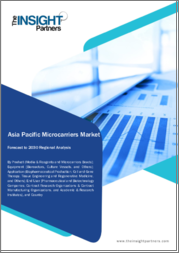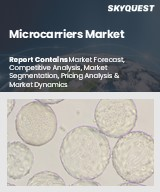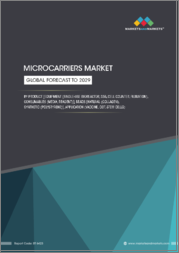
|
시장보고서
상품코드
1494454
아시아태평양의 마이크로캐리어 시장 예측(-2030년) : 지역별 분석 - 제품, 장비, 용도 및 최종 사용자별 분석Asia Pacific Microcarriers Market Forecast to 2030 - Regional Analysis - by Product, Equipment, Application, and End User |
||||||
아시아태평양의 마이크로캐리어 시장은 2022년 3억 6,614만 달러에서 2030년 9억 9,123만 달러로 성장할 것으로 예상되며, 2022-2030년간 CAGR은 13.3%를 나타낼 것으로 예상됩니다.
재생의료 도입 급증으로 아시아태평양 마이크로캐리어 시장 성장 견인할 것
재생의료의 채택 증가는 마이크로캐리어 시장의 성장을 가속하는 중요한 요인으로 작용하고 있습니다. 재생의료는 손상된 조직과 장기의 복구, 대체 및 재생에 초점을 맞추고 있으며, 다양한 질병을 치료할 수 있는 유망한 분야로 부상하고 있습니다. 마이크로캐리어는 재생의료의 기본인 세포의 배양과 증식에 있어 매우 중요한 역할을 합니다.
재생의료에서는 이식 전 체외에서 세포를 배양하는데, 마이크로캐리어는 세포의 접착, 증식, 분화에 적합한 환경을 말합니다. 마이크로캐리어는 바이오 리액터에서 세포 증식을 위한 기질로 작용하여 대량의 세포를 효율적으로 생산할 수 있도록 돕습니다. 이는 상당한 수의 생존 가능하고 기능적인 세포가 필요한 재생 치료에 특히 중요합니다.
또한, 마이크로캐리어는 세포 공정의 확장성과 비용 효율성을 향상시켜 재생 의료를 연구에서 임상 적용으로 전환하는 데 있어 중요한 과제를 해결합니다. 줄기세포 치료와 조직공학에 대한 관심이 높아짐에 따라 재생의료 분야의 발전이 지속됨에 따라 마이크로캐리어에 대한 수요가 확대되고 마이크로캐리어 시장의 혁신과 확장을 촉진할 것으로 예상됩니다.
아시아태평양 마이크로캐리어 시장 개요
아시아태평양의 마이크로캐리어 시장은 중국, 일본, 인도, 호주, 한국 및 기타 아시아태평양으로 나뉩니다. 아시아태평양의 여러 국가는 세포 및 유전자 치료 연구 개발에 많은 투자를 하고 있습니다. 중국, 인도, 일본은 이 지역의 마이크로캐리어 시장 성장에 크게 기여하는 세 나라로, 시장 성장의 배경에는 비용 최적화를 중시하는 기업 증가, 임상 프로세스 간소화 노력의 급증, 정부 지원 정책, 임상시험 건수 증가 등이 있습니다. 중화인민공화국 정부는 공중보건 향상, 비용 효율적인 공중보건 프로그램 제공, 건강 관련 재정 보호 조치의 적용 범위 확대, 방대한 의료 제공 네트워크에 대한 투자에 집중하고 있습니다. 중국의 13차 계획은 2020년 생명공학 산업의 GDP 기여도가 4%를 초과할 것으로 예상하고 있으며, 이는 10-20개에 가까운 생명과학 분야와 비슷한 규모입니다. 중국 전역에는 지방정부가 관리하는 100개 이상의 생명과학단지가 운영되고 있으며, 이들 센터는 세제 혜택과 보조금을 통해 기업을 유치하고 있습니다. 중국 5개년 계획의 목표를 달성하기 위해 미국, 지방 정부는 이미 1,000억 달러 이상을 생명과학 부문에 투자한 것으로 알려졌으며, 2003년 중국은 유전자 치료제를 승인한 최초의 국가가 되었고, 이후 전 세계적으로 치료 효과가 높은 세포치료제와 유전자 치료제의 개발이 가속화되고 있습니다. 2021년 네이처지에 발표된 연구에 따르면 중국은 전 세계 세포치료 임상시험의 50% 이상을 수행했습니다. 2021년 국가약품감독관리국(NMPA)이 Fosun Kite의 Yescarta와 JW Therapeutics의 Relma-cel을 승인하면서 중국의 세포치료는 새로운 시대를 맞이했습니다. 새로운 시대를 맞이했습니다.
아시아태평양의 마이크로캐리어 시장 매출 및 2030년까지의 예측(금액)
아시아태평양 마이크로캐리어 시장 세분화
아시아태평양의 마이크로캐리어 시장은 제품, 장비, 용도, 최종 사용자 및 국가별로 분류됩니다.
제품별로 아시아태평양의 마이크로캐리어 시장은 마이크로캐리어 비드와 배지 및 시약으로 나뉘며, 2022년 아시아태평양의 마이크로캐리어 시장에서 마이크로캐리어 비드 부문이 큰 비중을 차지할 것으로 예상됩니다.
장비 측면에서 아시아태평양의 마이크로캐리어 시장은 바이오리액터, 배양용기, 기타로 구분됩니다. 바이오리액터 부문은 2022년 아시아태평양의 마이크로캐리어 시장에서 가장 큰 점유율을 차지했습니다.
용도별로 아시아태평양의 마이크로캐리어 시장은 바이오 의약품 생산, 세포 및 유전자 치료, 조직 공학 및 재생 의학, 기타로 분류되며, 바이오 의약품 생산 부문이 2022년 아시아태평양의 마이크로캐리어 시장에서 가장 큰 점유율을 차지할 것으로 예상됩니다. 또한, 바이오 의약품 생산 부문은 치료용 단백질 생산과 백신 생산으로 분류됩니다.
최종 사용자를 기준으로 아시아태평양의 마이크로캐리어 시장은 제약 및 생명공학 기업, 위탁 연구 및 수탁 제조 기관, 학술 및 연구 기관으로 구분되며, 2022년 아시아태평양의 마이크로캐리어 시장에서 제약 및 생명공학 기업이 가장 큰 점유율을 차지할 것으로 예상됩니다.
국가별로 보면 아시아태평양의 마이크로캐리어 시장은 중국, 일본, 인도, 한국, 호주, 기타 아시아태평양으로 나뉘며, 2022년 아시아태평양의 마이크로캐리어 시장은 중국이 독주할 것입니다.
Teijin Ltd, Bio-Rad Laboratories Inc, Sartorius AG, Danaher Corp, Corning Inc, Eppendorf SE, Asahi Kasei Corp, Polysciences Inc는 아시아태평양의 마이크로캐리어 시장에서 사업을 전개하고 있는 주요 기업 중 일부입니다.
목차
제1장 서론
제2장 주요 요약
제3장 조사 방법
- 대상 범위
- 2차 조사
- 1차 조사
제4장 아시아태평양의 마이크로캐리어 시장 - 주요 산업 역학
- 주요 시장 성장 촉진요인
- 시장 성장 억제요인
- 시장 기회
- 향후 동향
- 영향 분석
제5장 마이크로캐리어 시장 : 아시아태평양 시장 분석
- 마이크로캐리어 시장 판매량, 2022-2030년
제6장 아시아태평양의 마이크로캐리어 시장 매출과 2030년까지 예측 : 제품별
- 서론
- 마이크로캐리어 시장 제품별 판매량 점유율(%), 2022년과 2030년
- 마이크로캐리어 비즈
- 배지 및 시약
제7장 아시아태평양의 마이크로캐리어 시장 : 기구별 매출과 2030년까지 예측
- 서론
- 마이크로캐리어 시장 기구별 판매량 점유율(%), 2022년과 2030년
- 바이오리액터
- 배양 용기
- 기타
제8장 아시아태평양의 마이크로캐리어 시장 매출과 2030년까지 예측 : 용도별
- 서론
- 마이크로캐리어 시장 용도별 판매량 점유율(%), 2022년과 2030년
- 바이오의약품 생산
- 세포 및 유전자 치료
- 조직공학 및 재생의료
- 기타
제9장 아시아태평양의 마이크로캐리어 시장 매출과 2030년까지 예측 : 최종사용자별
- 서론
- 아시아태평양의 마이크로캐리어 시장 : 최종사용자별 점유율, 2022년과 2030년(%)
- 제약 기업 및 바이오테크놀러지 기업
- 제약 기업 및 바이오테크놀러지 기업 : 마이크로캐리어 시장 - 2030년까지 매출과 예측
- 수탁연구기관 및 수탁제조 기관
- 수탁연구기관 및 수탁제조기관 : 마이크로캐리어 시장 : 2028년까지 매출과 예측
- 학술기관 및 연구기관
- 학술기관 및 연구기관 : 마이크로캐리어 시장 : 2028년까지 매출과 예측
제10장 아시아태평양의 마이크로캐리어 시장 매출과 2030년까지 예측 : 국가별 분석
- 아시아태평양
- 중국
- 일본
- 인도
- 호주
- 한국
- 기타 아시아태평양
제11장 마이크로캐리어 시장 - 업계 상황
- 서론
- 유기적 성장 전략
- 무기적 성장 전략
제12장 기업 개요
- Teijin Ltd
- Bio-Rad Laboratories Inc
- Sartorius AG
- Danaher Corp
- Corning Inc
- Eppendorf SE
- Asahi Kasei Corp
- Polysciences Inc
제13장 부록
LSH 24.06.21The Asia Pacific microcarriers market is expected to grow from US$ 366.14 million in 2022 to US$ 991.23 million by 2030. It is estimated to record a CAGR of 13.3% from 2022 to 2030.
Surge in Adoption of Regenerative Medicine Fuels Asia Pacific Microcarriers Market
The rising adoption of regenerative medicine has emerged as a significant driver propelling the growth of the microcarriers market. Regenerative medicine focuses on repairing, replacing, or regenerating damaged tissues and organs, making it a promising field for addressing various medical conditions. Microcarriers play a pivotal role in the cultivation and expansion of cells, a fundamental aspect of regenerative medicine.
In regenerative medicine, cells are cultured outside the body before being transplanted, and microcarriers provide a suitable environment for cell attachment, proliferation, and differentiation. They serve as a substrate for cell growth in bioreactors, facilitating the efficient production of large quantities of cells. This is particularly crucial for regenerative therapies, where a substantial number of viable and functional cells are needed.
Moreover, microcarriers enhance the scalability and cost-effectiveness of cell processes, addressing key challenges in the translation of regenerative medicine from research to clinical applications. As the regenerative medicine field continues to advance, with an increasing focus on stem cell therapies and tissue engineering, the demand for microcarriers is expected to escalate, driving innovation and expansion within the microcarriers market
Asia Pacific Microcarriers Market Overview
The microcarrier market in Asia Pacific is segmented into China, Japan, India, Australia, South Korea, and the Rest of Asia Pacific countries. Several countries in Asia Pacific invest significantly in cell and gene therapy R&D. China, India, and Japan are the three major contributors to the growth of the microcarriers market in this region, and the market growth can be attributed to the growing emphasis of businesses on cost optimization, burgeoning efforts to streamline clinical processes, supportive government policies, and increasing number of clinical trials. The government of the People's Republic of China is focused on improving public health, providing cost-effective public health programs, expanding the coverage of health-related financial protection measures, and investing in a vast healthcare delivery network. The 13th Chinese plan expected a more than 4% contribution of the biotechnology industry to the GDP in 2020, which would be nearly 10-20 life-science parities. More than 100 life-science parks controlled by local governments are functional across China, and these centers entice enterprises with tax advantages and subsidies. State, provincial, and local governments are reported to have already invested more than US$ 100 billion in the biosciences sector to meet the goals of the five-year plan of China. In 2003, it became the first country to approve a gene therapy, and since then, the development of cell and gene therapies with elevated therapeutic potential has picked pace worldwide. According to a study published in Nature in 2021, China is home to more than 50% of all cell therapy trials across the world. The country currently has nearly 400 ongoing CAR-T trials centered on hematology, and oncology and solid tumors. In 2021, the National Medical Products Administration (NMPA) approved Fosun Kite's Yescarta and JW Therapeutics' Relma-cel, with which cell therapies in China entered a new era.
Asia Pacific Microcarriers Market Revenue and Forecast to 2030 (US$ Million)
Asia Pacific Microcarriers Market Segmentation
The Asia Pacific microcarriers market is segmented into product, equipment, application, end user, and country.
Based on product, the Asia Pacific microcarriers market is bifurcated into microcarriers beads and media & reagents. The microcarriers beads segment held a larger share of the Asia Pacific microcarriers market in 2022.
In terms of equipment, the Asia Pacific microcarriers market is segmented into bioreactors, culture vessels, and others. The bioreactors segment held the largest share of the Asia Pacific microcarriers market in 2022.
Based on application, the Asia Pacific microcarriers market is segmented into biopharmaceutical production, cell and gene therapy, tissue engineering and regenerative medicine, and other. The biopharmaceutical production segment held the largest share of the Asia Pacific microcarriers market in 2022. Further, biopharmaceutical production segment is categorized into therapeutic protein production and vaccine production.
Based on end user, the Asia Pacific microcarriers market is segmented into pharmaceutical & biotechnology companies, contract research organizations & contract manufacturing organizations, and academic & research institutes. The pharmaceutical & biotechnology companies segment held the largest share of the Asia Pacific microcarriers market in 2022.
Based on country, the Asia Pacific microcarriers market is segmented into China, Japan, India, South Korea, Australia, and the Rest of Asia Pacific. China dominated the Asia Pacific microcarriers market in 2022.
Teijin Ltd, Bio-Rad Laboratories Inc, Sartorius AG, Danaher Corp, Corning Inc, Eppendorf SE, Asahi Kasei Corp, and Polysciences Inc are some of the leading companies operating in the Asia Pacific microcarriers market.
Table Of Contents
1. Introduction
- 1.1 The Insight Partners Research Report Guidance
- 1.2 Market Segmentation
2. Executive Summary
3. Research Methodology
- 3.1 Coverage
- 3.2 Secondary Research
- 3.3 Primary Research
4. Asia Pacific Microcarriers Market - Key Industry Dynamics
- 4.1 Key Market Drivers:
- 4.1.1 Need for Cell Therapies with Rising Incidence of Cancer and Infectious Diseases
- 4.1.2 Increasing Popularity of Outsourcing Cell and Gene Therapy Manufacturing
- 4.1.3 Surge in Adoption of Regenerative Medicine
- 4.2 Market Restraints
- 4.2.1 High Cost of Biologics and Cell-based Therapies
- 4.3 Market Opportunities
- 4.3.1 Strategic Initiatives and Innovative Products by Microcarrier Manufacturers
- 4.4 Future Trends
- 4.4.1 Automation of Cell and Gene Therapy Manufacturing Services
- 4.5 Impact Analysis
5. Microcarriers Market - Asia Pacific Market Analysis
- 5.1 Microcarriers Market Revenue (US$ Mn), 2022 - 2030
6. Asia Pacific Microcarriers Market - Revenue and Forecast to 2030 - by Product
- 6.1 Overview
- 6.2 Microcarriers Market Revenue Share, by Product 2022 & 2030 (%)
- 6.3 Microcarrier Beads
- 6.3.1 Overview
- 6.3.2 Microcarrier Beads: Microcarriers Market - Revenue and Forecast to 2030 (US$ Million)
- 6.4 Media and Reagents
- 6.4.1 Overview
- 6.4.2 Media and Reagents: Microcarriers Market - Revenue and Forecast to 2030 (US$ Million)
7. Asia Pacific Microcarriers Market - Revenue and Forecast to 2030 - by Equipment
- 7.1 Overview
- 7.2 Microcarriers Market Revenue Share, by Equipment 2022 & 2030 (%)
- 7.3 Bioreactors
- 7.3.1 Overview
- 7.3.2 Bioreactors: Microcarriers Market - Revenue and Forecast to 2030 (US$ Million)
- 7.4 Culture Vessels
- 7.4.1 Overview
- 7.4.2 Culture Vessels: Microcarriers Market - Revenue and Forecast to 2030 (US$ Million)
- 7.5 Others
- 7.5.1 Overview
- 7.5.2 Others: Microcarriers Market - Revenue and Forecast to 2030 (US$ Million)
8. Asia Pacific Microcarriers Market - Revenue and Forecast to 2030 - by Application
- 8.1 Overview
- 8.2 Microcarriers Market Revenue Share, by Application 2022 & 2030 (%)
- 8.3 Biopharmaceutical Production
- 8.3.1 Overview
- 8.3.2 Biopharmaceutical Production: Microcarriers Market - Revenue and Forecast to 2030 (US$ Million)
- 8.3.3 Therapeutic Protein Production: Microcarriers Market - Revenue and Forecast to 2030 (US$ Million)
- 8.3.4 Vaccine Production: Microcarriers Market - Revenue and Forecast to 2030 (US$ Million)
- 8.4 Cell and Gene Therapy
- 8.4.1 Overview
- 8.4.2 Cell and Gene Therapy: Microcarriers Market - Revenue and Forecast to 2030 (US$ Million)
- 8.5 Tissue Engineering and Regenerative Medicine
- 8.5.1 Overview
- 8.5.2 Tissue Engineering and Regenerative Medicine: Microcarriers Market - Revenue and Forecast to 2030 (US$ Million)
- 8.6 Others
- 8.6.1 Overview
- 8.6.2 Others: Microcarriers Market - Revenue and Forecast to 2030 (US$ Million)
9. Asia Pacific Microcarriers Market Revenue and Forecasts To 2030 - End User
- 9.1 Overview
- 9.2 Asia Pacific Microcarriers Market Share by End User - 2022 & 2030 (%)
- 9.3 Pharmaceutical and Biotechnology Companies
- 9.3.1 Overview
- 9.3.2 Pharmaceutical and Biotechnology Companies: Microcarriers Market- Revenue and Forecast to 2030 (US$ Million)
- 9.4 Contract Research Organizations and Contract Manufacturing Organizations
- 9.4.1 Overview
- 9.4.2 Contract Research Organizations and Contract Manufacturing Organizations: Microcarriers Market- Revenue and Forecast to 2028 (US$ Million)
- 9.5 Academic and Research Institutes
- 9.5.1 Overview
- 9.5.2 Academic and Research Institutes: Microcarriers Market- Revenue and Forecast to 2028 (US$ Million)
10. Asia Pacific Microcarriers Market Revenue and Forecasts to 2030 - Country Analysis
- 10.1 Asia Pacific Microcarriers Market, Revenue and Forecast To 2030
- 10.1.1 Overview
- 10.1.2 Asia Pacific: Microcarriers Market, by Country
- 10.1.2.1 China
- 10.1.2.1.1 Overview
- 10.1.2.1.2 China: Microcarriers Market Revenue and Forecast to 2030 (CHINA$ Mn)
- 10.1.2.1.3 China: Microcarriers Market, by Product
- 10.1.2.1.4 China: Microcarriers Market, by Equipment
- 10.1.2.1.5 China: Microcarriers Market, by Application
- 10.1.2.1.5.1 China: Microcarriers Market, by Biopharmaceutical Production
- 10.1.2.1.6 China: Microcarriers Market, by End User
- 10.1.2.2 Japan
- 10.1.2.2.1 Overview
- 10.1.2.2.2 Japan: Microcarriers Market Revenue and Forecast to 2030 (US$ Mn)
- 10.1.2.2.3 Japan: Microcarriers Market, by Product
- 10.1.2.2.4 Japan: Microcarriers Market, by Equipment
- 10.1.2.2.5 Japan: Microcarriers Market, by Application
- 10.1.2.2.5.1 Japan: Microcarriers Market, by Biopharmaceutical Production
- 10.1.2.2.6 Japan: Microcarriers Market, by End User
- 10.1.2.3 India
- 10.1.2.3.1 Overview
- 10.1.2.3.2 India: Microcarriers Market Revenue and Forecast to 2030 (US$ Mn)
- 10.1.2.3.3 India: Microcarriers Market, by Product
- 10.1.2.3.4 India: Microcarriers Market, by Equipment
- 10.1.2.3.5 India: Microcarriers Market, by Application
- 10.1.2.3.5.1 India: Microcarriers Market, by Biopharmaceutical Production
- 10.1.2.3.6 India: Microcarriers Market, by End User
- 10.1.2.4 Australia
- 10.1.2.4.1 Overview
- 10.1.2.4.2 Australia: Microcarriers Market Revenue and Forecast to 2030 (AUSTRALIA$ Mn)
- 10.1.2.4.3 Australia: Microcarriers Market, by Product
- 10.1.2.4.4 Australia: Microcarriers Market, by Equipment
- 10.1.2.4.5 Australia: Microcarriers Market, by Application
- 10.1.2.4.5.1 Australia: Microcarriers Market, by Biopharmaceutical Production
- 10.1.2.4.6 Australia: Microcarriers Market, by End User
- 10.1.2.5 South Korea
- 10.1.2.5.1 Overview
- 10.1.2.5.2 South Korea: Microcarriers Market Revenue and Forecast to 2030 (US$ Mn)
- 10.1.2.5.3 South Korea: Microcarriers Market, by Product
- 10.1.2.5.4 South Korea: Microcarriers Market, by Equipment
- 10.1.2.5.5 South Korea: Microcarriers Market, by Application
- 10.1.2.5.5.1 South Korea: Microcarriers Market, by Biopharmaceutical Production
- 10.1.2.5.6 South Korea: Microcarriers Market, by End User
- 10.1.2.6 Rest of Asia Pacific
- 10.1.2.6.1 Overview
- 10.1.2.6.2 Rest of Asia Pacific: Microcarriers Market Revenue and Forecast to 2030 (US$ Mn)
- 10.1.2.6.3 Rest of Asia Pacific: Microcarriers Market, by Product
- 10.1.2.6.4 Rest of Asia Pacific: Microcarriers Market, by Equipment
- 10.1.2.6.5 Rest of Asia Pacific: Microcarriers Market, by Application
- 10.1.2.6.5.1 Rest of Asia Pacific: Microcarriers Market, by Biopharmaceutical Production
- 10.1.2.6.6 Rest of Asia Pacific: Microcarriers Market, by End User
- 10.1.2.1 China
11. Microcarriers Market-Industry Landscape
- 11.1 Overview
- 11.2 Organic Growth Strategies
- 11.2.1 Overview
- 11.3 Inorganic Growth Strategies
- 11.3.1 Overview
12. Company Profiles
- 12.1 Teijin Ltd
- 12.1.1 Key Facts
- 12.1.2 Business Description
- 12.1.3 Products and Services
- 12.1.4 Financial Overview
- 12.1.5 SWOT Analysis
- 12.1.6 Key Developments
- 12.2 Bio-Rad Laboratories Inc
- 12.2.1 Key Facts
- 12.2.2 Business Description
- 12.2.3 Products and Services
- 12.2.4 Financial Overview
- 12.2.5 SWOT Analysis
- 12.2.6 Key Developments
- 12.3 Sartorius AG
- 12.3.1 Key Facts
- 12.3.2 Business Description
- 12.3.3 Products and Services
- 12.3.4 Financial Overview
- 12.3.5 SWOT Analysis
- 12.3.6 Key Developments
- 12.4 Danaher Corp
- 12.4.1 Key Facts
- 12.4.2 Business Description
- 12.4.3 Products and Services
- 12.4.4 Financial Overview
- 12.4.5 SWOT Analysis
- 12.4.6 Key Developments
- 12.5 Corning Inc
- 12.5.1 Key Facts
- 12.5.2 Business Description
- 12.5.3 Products and Services
- 12.5.4 Financial Overview
- 12.5.5 SWOT Analysis
- 12.5.6 Key Developments
- 12.6 Eppendorf SE
- 12.6.1 Key Facts
- 12.6.2 Business Description
- 12.6.3 Products and Services
- 12.6.4 Financial Overview
- 12.6.5 SWOT Analysis
- 12.6.6 Key Developments
- 12.7 Asahi Kasei Corp
- 12.7.1 Key Facts
- 12.7.2 Business Description
- 12.7.3 Products and Services
- 12.7.4 Financial Overview
- 12.7.5 SWOT Analysis
- 12.7.6 Key Developments
- 12.8 Polysciences Inc
- 12.8.1 Key Facts
- 12.8.2 Business Description
- 12.8.3 Products and Services
- 12.8.4 Financial Overview
- 12.8.5 SWOT Analysis
- 12.8.6 Key Developments
13. Appendix
- 13.1 About the Insight Partners
- 13.2 Glossary of Terms



















